Abstract
Gonorrhoea is normally diagnosed presumptively by the presence of intracellular Gram-negative cocci on a Gram stain and confirmed by culture of the causative organism, Neisseria gonorrhoeae. Alternative methods have been evaluated extensively for the detection of gonococci in clinical specimens including immunological techniques such as ELISA and immunofluorescence, DNA probes, genetic transformation and the limulus lysate assay. Some of these tests have proved as sensitive and specific for the detection of gonorrhoea in symptomatic men as the Gram stain but offer no advantage in time or cost. In women, no test has been found that shows a sensitivity and specificity sufficiently adequate for clinical use. Culture in men and women remains the method of choice for diagnosis. In addition the need to obtain the infecting organism for antibiotic susceptibility testing has not been overcome. In contrast, the rapid identification of N gonorrhoeae can be achieved within four hours using either monoclonal antibodies or by the detection of preformed enzymes. New methods for both the detection and identification of N gonorrhoeae should be carefully evaluated particularly for use in cases of child and sexual abuse where medico-legal problems may arise.
Full text
PDF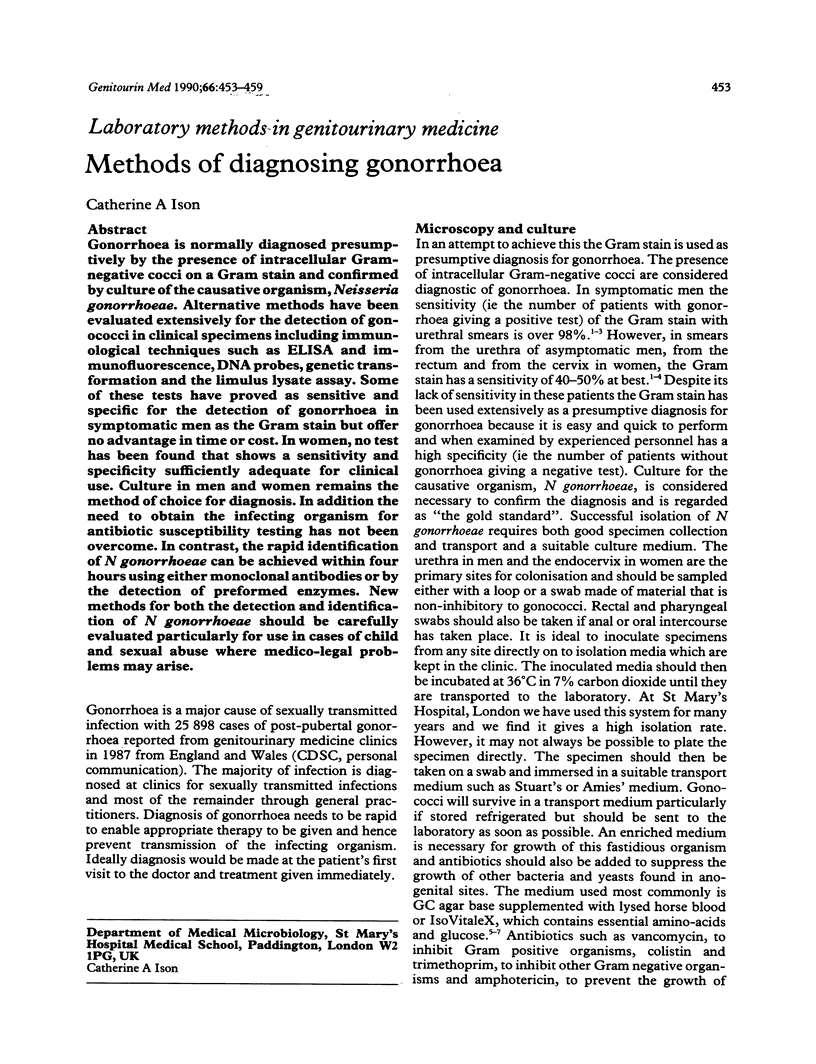
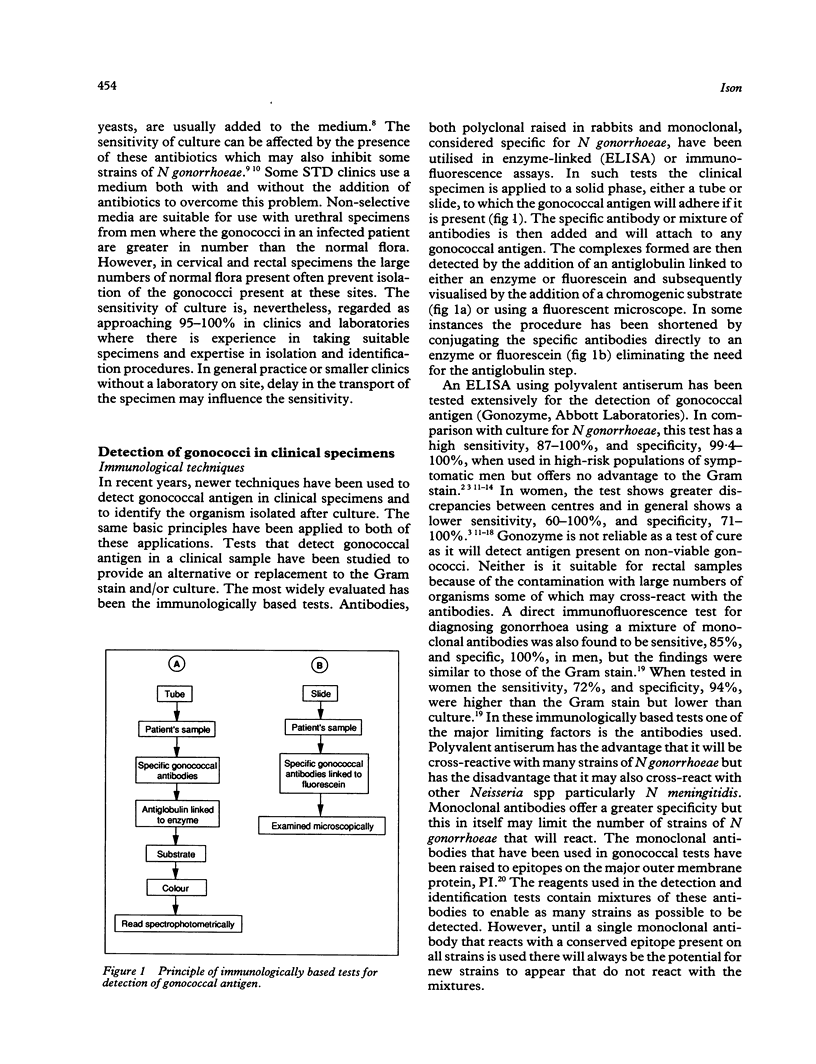
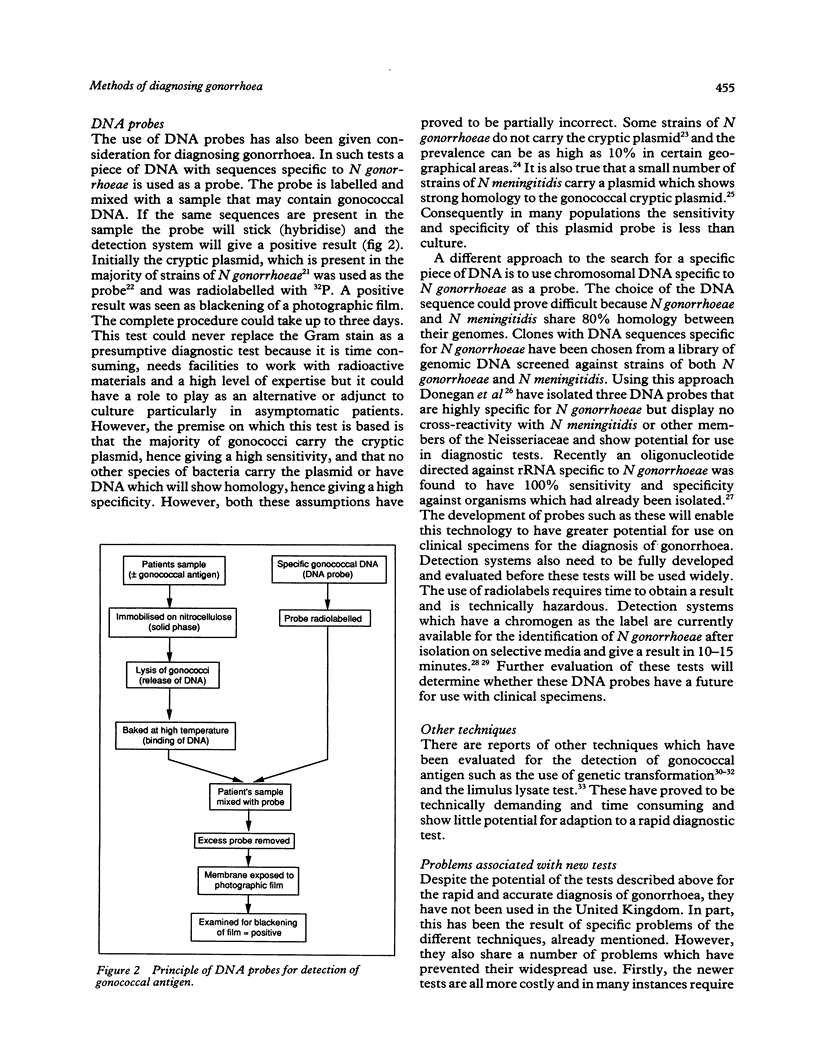
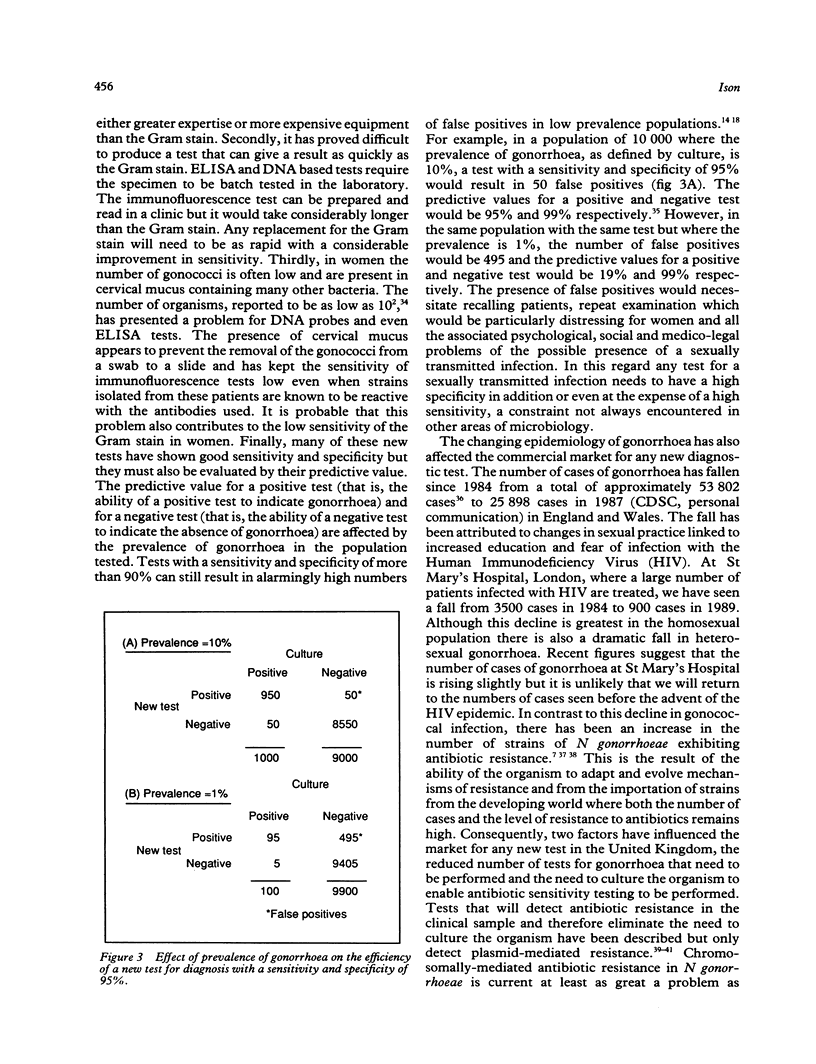
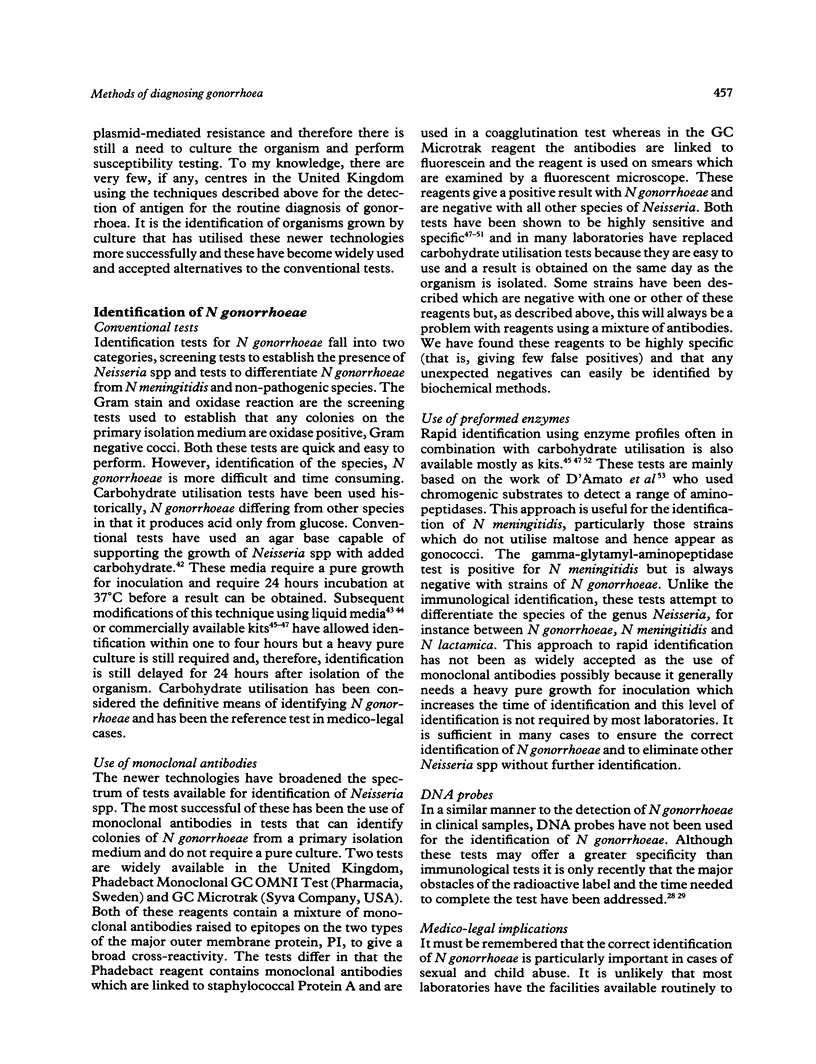
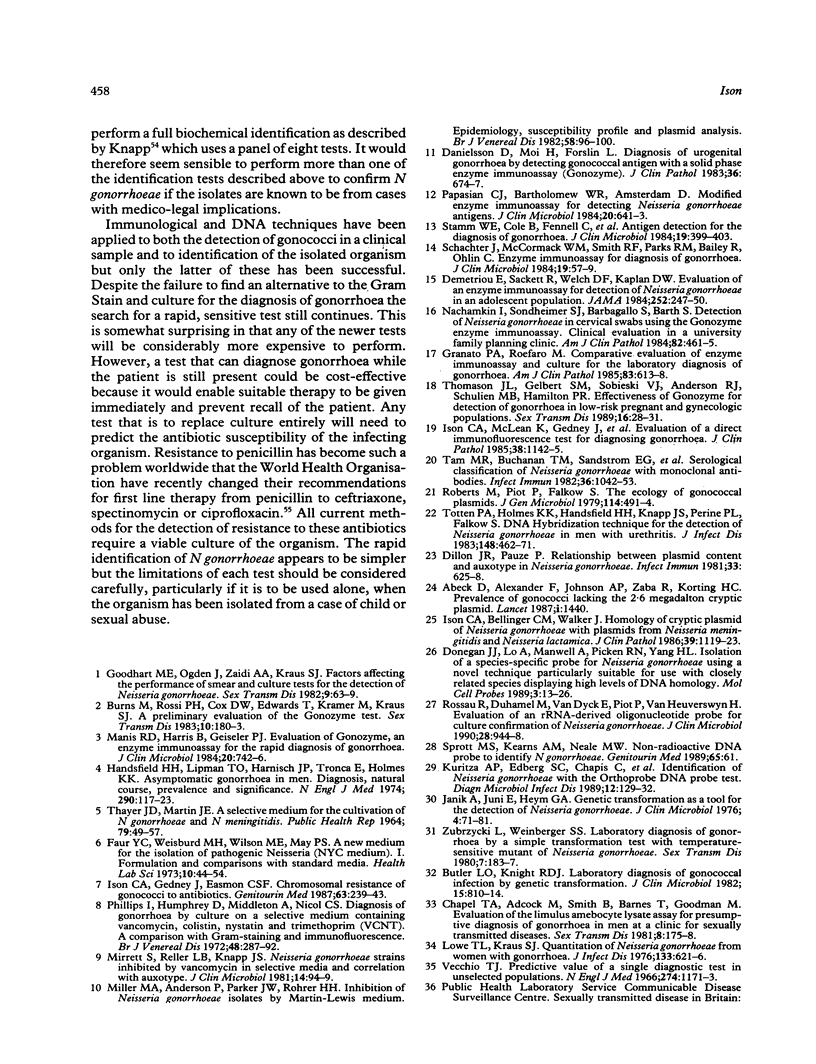
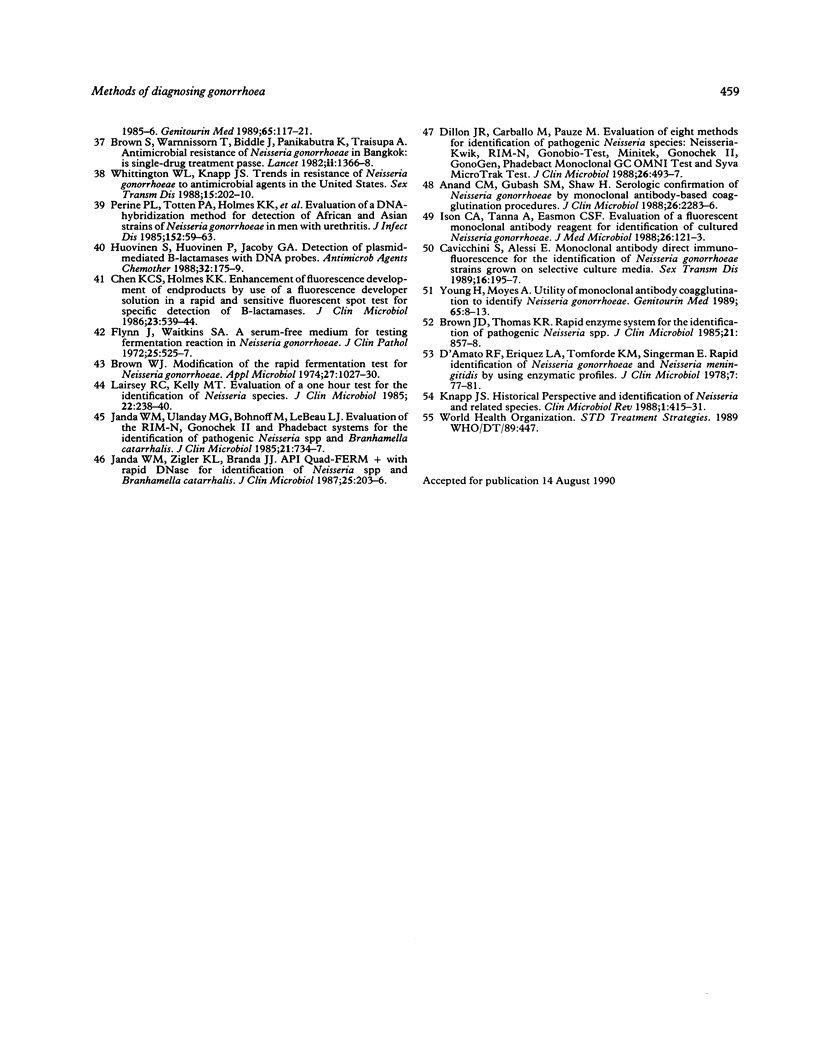
Selected References
These references are in PubMed. This may not be the complete list of references from this article.
- Abeck D., Alexander F., Johnson A. P., Korting H. C., Taylor-Robinson D. Prevalence of gonococci lacking the 2.6 megadalton cryptic plasmid. Lancet. 1987 Jun 20;1(8547):1440–1440. doi: 10.1016/s0140-6736(87)90635-0. [DOI] [PubMed] [Google Scholar]
- Anand C. M., Gubash S. M., Shaw H. Serologic confirmation of Neisseria gonorrhoeae by monoclonal antibody-based coagglutination procedures. J Clin Microbiol. 1988 Nov;26(11):2283–2286. doi: 10.1128/jcm.26.11.2283-2286.1988. [DOI] [PMC free article] [PubMed] [Google Scholar]
- Blackshaw A. J., Levison D. A. Eosinophilic infiltrates of the gastrointestinal tract. J Clin Pathol. 1986 Jan;39(1):1–7. doi: 10.1136/jcp.39.1.1. [DOI] [PMC free article] [PubMed] [Google Scholar]
- Brown J. D., Thomas K. R. Rapid enzyme system for the identification of pathogenic Neisseria spp. J Clin Microbiol. 1985 May;21(5):857–858. doi: 10.1128/jcm.21.5.857-858.1985. [DOI] [PMC free article] [PubMed] [Google Scholar]
- Brown S., Warnnissorn T., Biddle J., Panikabutra K., Traisupa A. Antimicrobial resistance of Neisseria gonorrhoea in Bangkok: is single-drug treatment passé. Lancet. 1982 Dec 18;2(8312):1366–1368. doi: 10.1016/s0140-6736(82)91271-5. [DOI] [PubMed] [Google Scholar]
- Brown W. J. Modification of the rapid fermentation test for Neisseria gonorrhoeae. Appl Microbiol. 1974 Jun;27(6):1027–1030. doi: 10.1128/am.27.6.1027-1030.1974. [DOI] [PMC free article] [PubMed] [Google Scholar]
- Burns M., Rossi P. H., Cox D. W., Edwards T., Kramer M., Kraus S. J. A preliminary evaluation of the Gonozyme test. Sex Transm Dis. 1983 Oct-Dec;10(4):180–183. doi: 10.1097/00007435-198311000-00003. [DOI] [PubMed] [Google Scholar]
- Butler L. O., Knight R. D. Laboratory diagnosis of gonococcal infection by genetic transformation. J Clin Microbiol. 1982 May;15(5):810–814. doi: 10.1128/jcm.15.5.810-814.1982. [DOI] [PMC free article] [PubMed] [Google Scholar]
- Cavicchini S., Alessi E. Monoclonal antibody direct immunofluorescence for the identification of Neisseria gonorrhoeae strains grown on selective culture media. Sex Transm Dis. 1989 Oct-Dec;16(4):195–197. doi: 10.1097/00007435-198910000-00008. [DOI] [PubMed] [Google Scholar]
- Chapel T. A., Adcock M., Smith B., Barnes T., Goodman M. Evaluation of the limulus amebocyte lysate assay for presumptive diagnosis of gonorrhea in men at a clinic for sexually transmitted diseases. Sex Transm Dis. 1981 Jul-Sep;8(3):175–178. doi: 10.1097/00007435-198107000-00001. [DOI] [PubMed] [Google Scholar]
- Chen K. C., Holmes K. K. Enhancement of fluorescence development of end products by use of a fluorescence developer solution in a rapid and sensitive fluorescent spot test for specific detection of microbial beta-lactamases. J Clin Microbiol. 1986 Mar;23(3):539–544. doi: 10.1128/jcm.23.3.539-544.1986. [DOI] [PMC free article] [PubMed] [Google Scholar]
- D'Amato R. F., Eriquez L. A., Tomfohrde K. M., Singerman E. Rapid identification of Neisseria gonorrhoeae and Neisseria meningitidis by using enzymatic profiles. J Clin Microbiol. 1978 Jan;7(1):77–81. doi: 10.1128/jcm.7.1.77-81.1978. [DOI] [PMC free article] [PubMed] [Google Scholar]
- Danielsson D., Moi H., Forslin L. Diagnosis of urogenital gonorrhoea by detecting gonococcal antigen with a solid phase enzyme immunoassay (Gonozyme). J Clin Pathol. 1983 Jun;36(6):674–677. doi: 10.1136/jcp.36.6.674. [DOI] [PMC free article] [PubMed] [Google Scholar]
- Demetriou E., Sackett R., Welch D. F., Kaplan D. W. Evaluation of an enzyme immunoassay for detection of Neisseria gonorrhoeae in an adolescent population. JAMA. 1984 Jul 13;252(2):247–250. [PubMed] [Google Scholar]
- Dillon J. R., Carballo M., Pauzé M. Evaluation of eight methods for identification of pathogenic Neisseria species: Neisseria-Kwik, RIM-N, Gonobio-Test, Minitek, Gonochek II, GonoGen, Phadebact Monoclonal GC OMNI Test, and Syva MicroTrak Test. J Clin Microbiol. 1988 Mar;26(3):493–497. doi: 10.1128/jcm.26.3.493-497.1988. [DOI] [PMC free article] [PubMed] [Google Scholar]
- Dillon J. R., Pauzé M. Relationship between plasmid content and auxotype in Neisseria gonorrhoeae isolates. Infect Immun. 1981 Aug;33(2):625–628. doi: 10.1128/iai.33.2.625-628.1981. [DOI] [PMC free article] [PubMed] [Google Scholar]
- Donegan J. J., Lo A., Manwell A., Picken R. N., Yang H. L. Isolation of a species-specific DNA probe for Neisseria gonorrhoeae using a novel technique particularly suitable for use with closely related species displaying high levels of DNA homology. Mol Cell Probes. 1989 Mar;3(1):13–26. doi: 10.1016/0890-8508(89)90033-9. [DOI] [PubMed] [Google Scholar]
- Faur Y. C., Weisburd M. H., Wilson M. E., May P. S. A new medium for the isolation of pathogenic Neisseria (NYC medium). I. Formulation and comparisons with standard media. Health Lab Sci. 1973 Apr;10(2):44–54. [PubMed] [Google Scholar]
- Flynn J., Waitkins S. A. A serum-free medium for testing fermentation reactions in Neisseria gonorrhoeae. J Clin Pathol. 1972 Jun;25(6):525–527. doi: 10.1136/jcp.25.6.525. [DOI] [PMC free article] [PubMed] [Google Scholar]
- Goodhart M. E., Ogden J., Zaidi A. A., Kraus S. J. Factors affecting the performance of smear and culture tests for the detection of Neisseria gonorrhoeae. Sex Transm Dis. 1982 Apr-Jun;9(2):63–69. doi: 10.1097/00007435-198204000-00002. [DOI] [PubMed] [Google Scholar]
- Granato P. A., Roefaro M. Comparative evaluation of enzyme immunoassay and culture for the laboratory diagnosis of gonorrhea. Am J Clin Pathol. 1985 May;83(5):613–618. doi: 10.1093/ajcp/83.5.613. [DOI] [PubMed] [Google Scholar]
- Handsfield H. H., Lipman T. O., Harnisch J. P., Tronca E., Holmes K. K. Asymptomatic gonorrhea in men. Diagnosis, natural course, prevalence and significance. N Engl J Med. 1974 Jan 17;290(3):117–123. doi: 10.1056/NEJM197401172900301. [DOI] [PubMed] [Google Scholar]
- Huovinen S., Huovinén P., Jacoby G. A. Detection of plasmid-mediated beta-lactamases with DNA probes. Antimicrob Agents Chemother. 1988 Feb;32(2):175–179. doi: 10.1128/aac.32.2.175. [DOI] [PMC free article] [PubMed] [Google Scholar]
- Ison C. A., Gedney J., Easmon C. S. Chromosomal resistance of gonococci to antibiotics. Genitourin Med. 1987 Aug;63(4):239–243. doi: 10.1136/sti.63.4.239. [DOI] [PMC free article] [PubMed] [Google Scholar]
- Ison C. A., McLean K., Gedney J., Munday P. E., Coghill D., Smith R., Harris J. R., Easmon C. S. Evaluation of a direct immunofluorescence test for diagnosing gonorrhoea. J Clin Pathol. 1985 Oct;38(10):1142–1145. doi: 10.1136/jcp.38.10.1142. [DOI] [PMC free article] [PubMed] [Google Scholar]
- Ison C. A., Tanna A., Easmon C. S. Evaluation of a fluorescent monoclonal antibody reagent for identification of cultured Neisseria gonorrhoeae. J Med Microbiol. 1988 Jun;26(2):121–123. doi: 10.1099/00222615-26-2-121. [DOI] [PubMed] [Google Scholar]
- Janda W. M., Ulanday M. G., Bohnhoff M., LeBeau L. J. Evaluation of the RIM-N, Gonochek II, and Phadebact systems for the identification of pathogenic Neisseria spp. and Branhamella catarrhalis. J Clin Microbiol. 1985 May;21(5):734–737. doi: 10.1128/jcm.21.5.734-737.1985. [DOI] [PMC free article] [PubMed] [Google Scholar]
- Janda W. M., Zigler K. L., Bradna J. J. API QuadFERM+ with rapid DNase for identification of Neisseria spp. and Branhamella catarrhalis. J Clin Microbiol. 1987 Feb;25(2):203–206. doi: 10.1128/jcm.25.2.203-206.1987. [DOI] [PMC free article] [PubMed] [Google Scholar]
- Janik A., Juni E., Heym G. A. Genetic Transformation as a tool for detection of Neisseria gonorrhoeae. J Clin Microbiol. 1976 Jul;4(1):71–81. doi: 10.1128/jcm.4.1.71-81.1976. [DOI] [PMC free article] [PubMed] [Google Scholar]
- Knapp J. S. Historical perspectives and identification of Neisseria and related species. Clin Microbiol Rev. 1988 Oct;1(4):415–431. doi: 10.1128/cmr.1.4.415. [DOI] [PMC free article] [PubMed] [Google Scholar]
- Kuritza A. P., Edberg S. C., Chapis C., Gallo P. Identification of Neisseria gonorrhoeae with the ORTHOProbe DNA probe test. Diagn Microbiol Infect Dis. 1989 Mar-Apr;12(2):129–132. doi: 10.1016/0732-8893(89)90002-3. [DOI] [PubMed] [Google Scholar]
- Lairscey R. C., Kelly M. T. Evaluation of a one-hour test for the identification of Neisseria species. J Clin Microbiol. 1985 Aug;22(2):238–240. doi: 10.1128/jcm.22.2.238-240.1985. [DOI] [PMC free article] [PubMed] [Google Scholar]
- Lowe T. L., Kraus S. J. Quantitation of Neisseria gonorrhoeae from women with gonorrhea. J Infect Dis. 1976 Jun;133(6):621–626. doi: 10.1093/infdis/133.6.621. [DOI] [PubMed] [Google Scholar]
- Manis R. D., Jr, Harris B., Geiseler P. J. Evaluation of Gonozyme, an enzyme immunoassay for the rapid diagnosis of gonorrhea. J Clin Microbiol. 1984 Oct;20(4):742–746. doi: 10.1128/jcm.20.4.742-746.1984. [DOI] [PMC free article] [PubMed] [Google Scholar]
- Miller M. A., Anderson P., Parker J. W., Rohrer H. H. Inhibition of Neisseria gonorrhoeae isolates by Martin-Lewis medium. Epidemiology, susceptibility profile, and plasma analysis. Br J Vener Dis. 1982 Apr;58(2):96–100. doi: 10.1136/sti.58.2.96. [DOI] [PMC free article] [PubMed] [Google Scholar]
- Mirrett S., Reller L. B., Knapp J. S. Neisseria gonorrhoeae strains inhibited by vancomycin in selective media and correlation with auxotype. J Clin Microbiol. 1981 Jul;14(1):94–99. doi: 10.1128/jcm.14.1.94-99.1981. [DOI] [PMC free article] [PubMed] [Google Scholar]
- Nachamkin I., Sondheimer S. J., Barbagallo S., Barth S. Detection of Neisseria gonorrhoeae in cervical swabs using the Gonozyme enzyme immunoassay. Clinical evaluation in a university family planning clinic. Am J Clin Pathol. 1984 Oct;82(4):461–465. doi: 10.1093/ajcp/82.4.461. [DOI] [PubMed] [Google Scholar]
- Papasian C. J., Bartholomew W. R., Amsterdam D. Modified enzyme immunoassay for detecting Neisseria gonorrhoeae antigens. J Clin Microbiol. 1984 Oct;20(4):641–643. doi: 10.1128/jcm.20.4.641-643.1984. [DOI] [PMC free article] [PubMed] [Google Scholar]
- Perine P. L., Totten P. A., Holmes K. K., Sng E. H., Ratnam A. V., Widy-Wersky R., Nsanze H., Habte-Gabr E., Westbrook W. G. Evaluation of a DNA-hybridization method for detection of African and Asian strains of Neisseria gonorrhoeae in men with urethritis. J Infect Dis. 1985 Jul;152(1):59–63. doi: 10.1093/infdis/152.1.59. [DOI] [PubMed] [Google Scholar]
- Phillips I., Humphrey D., Middleton A., Nicol C. S. Diagnosis of gonorrhoea by culture on a selective medium containing vancomycin, colistin, nystatin and trimethoprim (VCNT). A comparison with Gram-staining and immunofluorescence. Br J Vener Dis. 1972 Aug;48(4):287–292. doi: 10.1136/sti.48.4.287. [DOI] [PMC free article] [PubMed] [Google Scholar]
- Roberts M., Piot P., Falkow S. The ecology of gonococcal plasmids. J Gen Microbiol. 1979 Oct;114(2):491–494. doi: 10.1099/00221287-114-2-491. [DOI] [PubMed] [Google Scholar]
- Rossau R., Duhamel M., Van Dyck E., Piot P., Van Heuverswyn H. Evaluation of an rRNA-derived oligonucleotide probe for culture confirmation of Neisseria gonorrhoeae. J Clin Microbiol. 1990 May;28(5):944–948. doi: 10.1128/jcm.28.5.944-948.1990. [DOI] [PMC free article] [PubMed] [Google Scholar]
- Schachter J., McCormack W. M., Smith R. F., Parks R. M., Bailey R., Ohlin A. C. Enzyme immunoassay for diagnosis of gonorrhea. J Clin Microbiol. 1984 Jan;19(1):57–59. doi: 10.1128/jcm.19.1.57-59.1984. [DOI] [PMC free article] [PubMed] [Google Scholar]
- Sprott M. S., Kearns A. M., Neale M. W. Non-radioactive DNA probe to identify Neisseria gonorrhoeae. Genitourin Med. 1989 Jan;65(1):60–61. doi: 10.1136/sti.65.1.60-b. [DOI] [PMC free article] [PubMed] [Google Scholar]
- Stamm W. E., Cole B., Fennell C., Bonin P., Armstrong A. S., Herrmann J. E., Holmes K. K. Antigen detection for the diagnosis of gonorrhea. J Clin Microbiol. 1984 Mar;19(3):399–403. doi: 10.1128/jcm.19.3.399-403.1984. [DOI] [PMC free article] [PubMed] [Google Scholar]
- THAYER J. D., MARTIN J. E., Jr A SELECTIVE MEDIUM FOR THE CULTIVATION OF N. GONORRHOEAE AND N. MENINGITIDIS. Public Health Rep. 1964 Jan;79:49–57. [PMC free article] [PubMed] [Google Scholar]
- Tam M. R., Buchanan T. M., Sandström E. G., Holmes K. K., Knapp J. S., Siadak A. W., Nowinski R. C. Serological classification of Neisseria gonorrhoeae with monoclonal antibodies. Infect Immun. 1982 Jun;36(3):1042–1053. doi: 10.1128/iai.36.3.1042-1053.1982. [DOI] [PMC free article] [PubMed] [Google Scholar]
- Thomason J. L., Gelbart S. M., Sobieski V. J., Anderson R. J., Schulien M. B., Hamilton P. R. Effectiveness of Gonozyme for detection of gonorrhea in low-risk pregnant and gynecologic populations. Sex Transm Dis. 1989 Jan-Mar;16(1):28–31. doi: 10.1097/00007435-198901000-00006. [DOI] [PubMed] [Google Scholar]
- Totten P. A., Holmes K. K., Handsfield H. H., Knapp J. S., Perine P. L., Falkow S. DNA hybridization technique for the detection of Neisseria gonorrhoeae in men with urethritis. J Infect Dis. 1983 Sep;148(3):462–471. doi: 10.1093/infdis/148.3.462. [DOI] [PubMed] [Google Scholar]
- Vecchio T. J. Predictive value of a single diagnostic test in unselected populations. N Engl J Med. 1966 May 26;274(21):1171–1173. doi: 10.1056/NEJM196605262742104. [DOI] [PubMed] [Google Scholar]
- Whittington W. L., Knapp J. S. Trends in resistance of Neisseria gonorrhoeae to antimicrobial agents in the United States. Sex Transm Dis. 1988 Oct-Dec;15(4):202–210. doi: 10.1097/00007435-198810000-00006. [DOI] [PubMed] [Google Scholar]
- Young H., Moyes A. Utility of monoclonal antibody coagglutination to identify Neisseria gonorrhoeae. Genitourin Med. 1989 Jan;65(1):8–13. doi: 10.1136/sti.65.1.8. [DOI] [PMC free article] [PubMed] [Google Scholar]
- Zubrzycki L., Weinberger S. S. Laboratory diagnosis of gonorrhea by a simple transformation test with a temperature-sensitive mutant of Neisseria gonorrhoeae. Sex Transm Dis. 1980 Oct-Dec;7(4):183–187. doi: 10.1097/00007435-198010000-00008. [DOI] [PubMed] [Google Scholar]


